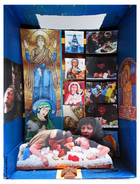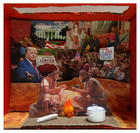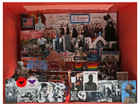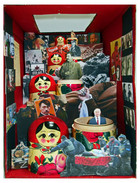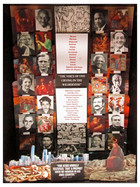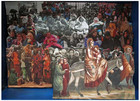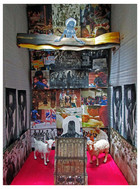Collage Story Boxes
While reorganizing my art collection recently, I took a closer look at three “found object”art pieces in display boxes I made over 15 years ago at an assemblage workshop. So much has changed since then. Thousands of images can now be downloaded on the internet. There is no need to bin dive in search of castaway items when you can find all kinds of odds and ends at on-line sources. And there is no shortage of containers from amazon.com deliveries! This has all proved so tempting, I have turned to artmaking—like Grandma Moses— in my seventies in a series of Collage Story Boxes.
My small scale. three-dimensional, mixed media offerings draw on a variety of influences from historical dioramas and pop-up cards to model stage sets and folk art retablos. Working with a reinforced cardboard container, I build up visual layers with cut-out images gleaned from on-line photos glued on cardboard like "flats" added by a theater designer to a miniature mock-up stage set. Small objects often find their place on levels like accessories in a dollhouse. There is the occasional text taken from newspapers, books, and magazines, but I mostly hold to the adage about an image equalling a thousand words.
Checking out dozes of contemporary dioramas on line, I found most of them to be a bit kitschy and uninspired. I have no particular interest in glorifying an idealized past, celebrating home and hearth, or delighting you with clever cut-outs. Call me a grumpy old man, if you like, but I’ve reached a time in life when I need an outlet to share simple home truths in a novel visual way about what I consider to be the self-absorbed life we lead and the vital issues we ignore. So, if you are a bit squeamish about disturbing images or strongly object to mixing “politics” with sacred art, these unedited reflections confined in cardboard are not for you.
Cardboard is considered an unstable art ground with a high acid content that easily warps, absorbs moisture, and degrades over time. Inkjet prints ultimately fade. In an age of Ephemeral Art when an artistic “expression” may be a one time event or intentionally made as a perishable piece, the shelf-life of my collage story boxes does not greatly concern me once I have made my visual point. In fact, it would be a blessing, if message art pieces of this kind became irrelevent and human beings finally learned to treat one another and the world they live in with the God-given respect they deserve.
My first collage story box in fifteen years, Ukrainian Pieta, is devoted to a theme close to my heart, the tragic human cost of Ukraine's struggle against Russian invaders. Inspiration came from a sticker of "Saint Javelin" from a Ukrainian shop with a paradoxical image of a Byzantine holy woman craddling a Javelin anti-tank weapon like a child in arms. I paired four icons from Ukrainian Greek Catholic women in my collection, depicting a distraught Virgin Mary holding the lifeless body of Christ, with press photos of Ukrainian women grieving for family members slain in the war. A carved wood pendant crucifix lies face up before a final picture of parents mourning a child killed in a Russian missile attack. The Mother of Christ in a 11th century mosaic in Kyiv's St. Sophia Cathedral presides over the scene with arms raised in a prayer of protection for the Ukrainian people.
I venture into politics with my second box, "My Name is Legion," comparing the assault on the U.S. Capitol on January 6, 2021, when Donald Trump stirred up an angry crowd of his followers to "Save Americe" and overturn the election results, with a very different "mob" scene in the Bible. The title, “My Name is Legion,” comes from the fifth chapter of Mark’s Gospel where Jesus exorcises a demon-possessed man by sending this self-identified evil force within him into a hapless herd of swine that drowns in a frenzied dash into the Sea of Galilee. It’s a disturbing story, and I added a touch of levity by incorporating Beppa Pig Family figures and a caricature from Brian Whelan, but the wood engraving of Christ with the healed demoniac from Illustrator Fritz Eichenberg (with a JESUS SAVES sticker!) makes my all too serious point: Don’t put your faith in Fake Saviors who are out to exploit you. Find the real one.
Growing up in a Fundamentalist church, I came to know by heart moral tales in the Bible like the Old Testament story of how the ravenously hungry Esau gave his birthright away to his trickster brother, Jacob, for a bowl of soup—called “a mess of pottage.” My third collage box is directed at Evangelical Christians who have compromised their core beliefs to follow Donald Trump in the misguided pursuit of political power just as Esau handed over his inheritance to eat his fill of pottage, symbolized by the dried soup packet the Republican leader holds out to his “Bible-believing” admirers. Next to a refrigerator magnate of the White House, there is an image by the Italian medieval painter, Duccio, of Christ rejecting Satan’s offer of all the kingdoms on earth if he would bow down and worship him. Trump has added tawdry gold sneakers and a Chinese-printed Bible to “sweeten” the exchange, but as Christ reminds us, there is no profit in gaining the whole world, if you lose your own soul.
The Puritans came to the New World to found what their leader, John Winthrop, using the words of Jesus, called “A City on a Hill,” a model society for all to follow based on Christian values. In my fourth collage story box, we fast forward to the modern era to see how this faith-based example of right-living (viewed with skepticism from the beginning by displaced indigenous peoples!) evolved over time into a gated community for privileged White Protestant men with their showy estates and golf courses, Wall Street board seats, and exclusionary churches. Cries for justice from those locked out echo through the valley below. While immigrants are kept in cages, and conservative Supreme Court justices serve as "doormen," American Jews decry all too frequent hate crimes, Native Americans face down Federal agents on their land, women fight for control over their lives and bodies, the LGBTQ community presses for equal rights, Latino migrant workers follow the path of iconic union organizer, Cesar Chavez, and African Americans proclaim Black lives matter, too!
My fifth biblical diorama offers a modern reading of Psalm 148 aimed at climate change deniers. Each verse in this paean to God is matched with images of the ways humanity has despoiled and destroyed these wonders of Creation that praise their Maker in the ancient text. While God looks down in grief from Paradise and headlines scream of looming environmental disasters, space probes pierce the heavenly heights, the waters “above” spin in threatening storm clouds, the “dragons” of the polluted deep lie slaughtered in fish kills, and lightning fires, blizzards, tornadoes and hurricanes ravage the overheated planet. The foothills of Mount Everest are blanketed in trash, mighty cedars fall to loggers, wild animals suffer in cages and cattle in factory pens, while wild birds smother in oil slicks. The peoples of the earth are lorded over by despots, would-be autocrats and religious bigots, divided among the very rich and the very poor, one and all at the mercy of global pandemics. Little wonder the Psalmist David, surveying the scene, sinks ever deeper into a trash dump!
Working on the “Mother Russia” box helped bring me closure, after trying (and failing!) all my professional life to understand the “riddle, wrapped in a mystery, inside an enigma,” which, in Churchill’s words, is Russia. The central motif of the piece is the familiar Matryoshka nesting doll with its sweetly maternal smile. Take it apart and what do your find “hatched” inside? The open dolls in their settings offer evidence of a despotic disregard for human life and values, running like a blood red thread through Russian history, beginning with Ivan the Terrible, the first Russian Tsar, througn the Communist regimes of Lenin and Stalin to today’s smaller-than-life, would-be emperor, Putin. Tsar Ivan cradles the son he bludgeoned to death above the bullet shredded room where the Romanov dynasty ended in blood. The bound hands of a World War II Polish officer massacred in the Soviet killing field of Katyn are repeated in those of a Ukrainan murdered in Bucha in the Russian invasion of 2022. Mug shots of prominent prisoners of the Stalinist concentration camps stare across at funeral portraits of notable Russians killed in the Putin era.
My “Voices in the Wilderness” collage is about prophets, old and new. Much is made of their ability to foretell the future, but, in reality, prophets simply warn us with dire words of the likely consequences of actions we already know in our hearts to be wrong. Often putting their lives at risk, they dare to “speak truth to power.” The Hebrew Scriptures abound with stories of prophets, seen here in color reproductions of artworks from Great Masters like Michelangelo and Rembrandt, taking us from Moses to John the Baptist (with my inclusion of Miriam, Deborah, and Anna in the Temple!) They are paired with 14 modern truth-tellers in black and white portrait photos whose messages have resonated with me. A solitary Jesus laments the fate of prophets in a visual strip at the bottom, looking out over heaps of dried bones and the Manhattan skyline with a text bloc as true in meaning as ever. Four out of my 14 modern prophets were gunned down by assassins and another two were killed in prison.
In the tragic sequel to the Christmas story in the Gospel of Matthew, an angel warns Joseph to take Mary and the Baby Jesus and flee for their lives from the murderous plotting of King Herod to a safe haven in Egypt. In my story box “Families in Flight,” the Holy Family, seen here in the Italian Medieval Master Giotto’s depiction of the Flight into Egypt, is the archetype of countless millions of families throughout history, forced to seek shelter in alien lands. The background collage of photographs shows Armenians fleeing the Turks, Greeks uprooted from Asia Minor, Jews in Nazi “transports,” Chinese trapped in Japanese-held Nanking, Hindus and Muslims after the 1946 Partition of India, and numberless other refugees of wars, genocidal confiicts, and civil unrest in Vietnam, Cambodia, Rwanda, Sudan, the Balkans, Haiti, Syria, Afghanistan, and, most recently, Ukraine and Gaza. The UN High Commissioner for Refugees estimates that in just the first half of 2024 close to 122 million people were forced to leave their homes. If gathered in a single state, they would make up the most populous nation in the European Union
My reading of Christ's account of the Last Judgment in the Gospel of Matthew suggested visual motifs for a collage story box depicting Christ the Judge separating the sheep from the goats (symbols of human types) based on whether those under judgment practiced six acts of mercy to "the least of these brothers and sisters of mine" Looking over the shoulder of Christ, enthroned with a retinue of angels, we see a sheep and goat from two herds at his right and his left hand awaiting the divine verdict. A central vertical strip shows those to whom we should have been merciful, if we, ourselves, expect to be shown mercy: the hungry, the thirsty, the stranger, the naked, the sick and the imprisoned. On the "sheep" side of this great divide are images of communal kitchens and clothing recycling centers, people offering water bottles and welcoming immigrants, and visitors to the sick and imprisoned. The "goat" side shows people heartlessly ignoring others in need and even working against them. At the center of the display, we see Christ standing unrecognized in a breadline, reminding us what we do to others we do to him. This wood engraving is the work of German-American Illustrator Fritz Eichenberg, a longtime contributor to the Catholic Worker newspaper of Social Activist Dorothy Day, who also provided the image of Christ at his Second Coming as a compassionate savior rather than a stern king.


